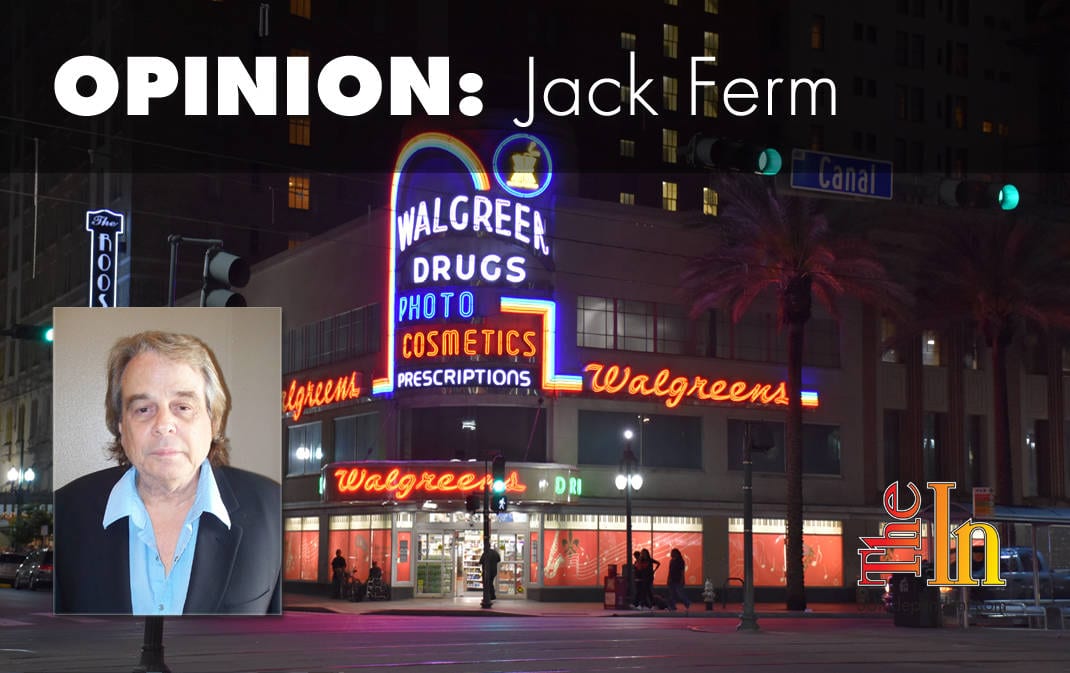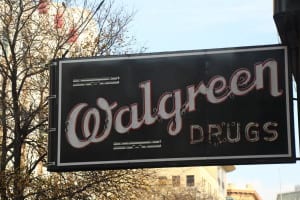
“There’s a sucker born every minute.” That phrase was actually about P.T. Barnum, a mid-19th Century showman, but is probably better ascribed to Walgreen’s, a modern-day practitioner of the philosophy that has preyed on consumers’ trust, confidence, and ignorance for at least the last several decades, if not longer.
Walgreen’s currently operates 8,217 stores in all 50 states and writes monthly prescriptions of about 894 million including immunizations. It has also paid out court settlements to several Attorneys General in several states. The settlements include overcharging as well as Medicare and Medicaid fraud.
What tuned me in to its overcharging practices and got me interested in researching it was that I was also a victim of the Walgreen’s overcharging scam.
Like most consumers, I failed to do my due diligence and check prices with other pharmacies, until now. It cost me, and it is costing you, the consumer, anywhere from $15 to $50 a month and maybe even more depending on the number of prescription drugs Walgreen’s fills for you.
I don’t have Medicare Part D, so I was paying the costs out of my own pocket as this medication was temporary, which was really no excuse. I had not considered that cheating the public by overcharging was Walgreen’s main profit source.
Most seniors on high-maintenance medications will carry Medicare Part D, in which case they often don’t pay attention to drug costs. This makes it easier for a drug store chain like Walgreen’s, Rite Aid, or CVS to overcharge and go unnoticed until sued by the government.
Prescription drugs become more ubiquitous the older the population becomes. Yet there are certain diseases that require long-term medication and are not bound strictly to seniors, like diabetes, Parkinson’s disease, HIV, AIDS, MS, and cancer.

Walgreen’s tops the complaint list
Walgreen’s consistently violates the trust of its customers by overcharging us. I am also guilty of that trust, and it cost me nearly $50 a month in overcharges by our Walgreen’s pharmacy right here in St. George — that is, until recently.
I was given a new prescription drug that I will be on for the next 12 months. After being charged $3.40 a pill ($102.21 for 30 pills), I became suspicious and called my medical provider, requesting her to prescribe a generic. That was when I discovered that she had. When I told her what I paid, she was as surprised as I was.
At that point, I began checking around. The actual cost should have been $2.33 a pill.
At that point, I called Walgreen’s and left a message on the pharmacy voicemail demanding to know why I was being overcharged on my medications. A short time later, I received a call from a man in the pharmacy. When I asked him about the charges, his reply was, “That’s our price … don’t like it, go someplace else.”
I did.
I called Stapley’s Pharmacy and had my prescriptions transferred to them. Their prices are lower than any of the chain pharmacies.

The problem with seniors
Seniors on Medicare Part D don’t question the charges as they don’t pay them — the insurer does.
But when Walgreen’s is overcharging the Medicare Part D provider — let’s say $30 a month for a single prescription — and they claim to fill 894 million prescriptions a month. Meanwhile, drug prices and insurance rates go up while Walgreen’s pockets $26,820,000 a month in overcharges alone.
I called the Walgreen’s main office at (800) 925-4733 and informed them of the overcharging and the comment about taking my business elsewhere. I don’t believe anything will come of the call. They never even asked for my name or contact information. They can afford to lose 1,000 prescriptions or more a month, because the overcharges are so overwhelmingly profitable.
It’s time to start checking your prescription drug pricing. There are hundreds if not thousands of young people on life-long drugs like Metformin and Pioglitazone who are being overcharged by Walgreen’s. They most likely don’t have insurance and have no knowledge of Walgreen’s scam.
I have the receipts to prove every word in this article. I have offered Walgreen’s an opportunity to respond. It declined.
In closing, I would like to provide some insight how contract law plays into our daily life and our consumer purchases.
Every activity where we are either a buyer or seller is based on contract law.
When we go to Walgreen’s to have our prescription filled and Walgreen’s accepts that prescription and agrees to fill it, that is a contract. All contracts involve an implied covenant of good faith and fair dealing. When Walgreen’s acts contrary to these implied covenants, they are in breach of the covenants and are liable for three times the actual damages.
This overcharge is a good candidate for yet another class action lawsuit if we show, for example, that Walgreen’s overcharged $26 billion a month over the past two years. A trial would expose this corrupt chain to three times the proven overcharges as exemplary damages.
It’s time to close Walgreen’s.




Makes sense to me. Buyer beware. I was paying $27/ bottle for a genaric, cholestrol lowering drug,
(my part D share) at Wallgreens. Went next door to Smiths, same dam item/ quanity cost $9 bucks.
However, you could make the same case with Smith’s food product cost vs. Walmart.
The government’s cost? example: A $12.95 shovel cost the Fed $187.00 Same shovel? you bet.
Must be the overhead cost.
This entire article is ridiculous and you clearly have no idea how pharmacy/insurance/drug pricing works. A pharmacy, be it walgreens or anywhere else, is entitled to charge whatever they want “cash price” for toilet paper, toothpaste, and yes, medicine. They aren’t “overcharging” you, they are charging you their price. What you must mean to say is that their prices are high. If you think the price is too high, you are welcome to shop elsewhere as you would for any other good.
As to your second point, the vast majority of people have prescription drug coverage, and therefore do not pay the cash price, but a copay which is determined by their insurance company. The insurance company does not pay the “cash price” to the pharmacy, reimbursement for drugs is negotiated between the pharmacy and the insurance company. You have absolutely no idea what the insurance plan is reimbursing the pharmacy, and to suggest they are somehow “overcharging” the insurance is simply incorrect. I might add that many times the insurance company does not even reimburse the pharmacy for the full cost of the drug, and pharmacies often make only pennies or even LOSE money on prescriptions they fill. This unfortunate situation of minimal reimbursement by the insurers means that pharmacy margins are being squeezed. Cash paying customers pay the price set by the pharmacy, which often has quite a mark up. This helps offset the losses/shrinking margins from insured claims. EVERY PHARMACY DOES THIS. Hate to break it to you but you are NOT paying the pharmacy the same price for your drugs that an insurance company is, you are being charged much more as a cash customer. It is TRUE, that big chains tend to inflate these prices more than most, but again, as a cash paying customer you are entitled to and should, shop around. If there is anyone to blame for increasing cash drug prices, you can blame the insurers, whom you somehow portray as victims of overcharging.
I’m not trying to come off as rude or unprofessional but so much of what you say in this article is just completely wrong and you should really do more research before making such ridiculous claims.
Pharmacist: sorry to bust your arrogant bubble in your attempt to defend your employer Walgreens. But your claims are rubbish.
Your employer has been sued by just about everyone state AG’s for overpricing…here are some links you might want to review….maybe try and get an honest job with a company that does not run pricing scams.
http://www.hometownstation.com/santa-clarita-news/cvs-walgreens-to-pay-5-million-in-drug-overcharge-settlement-27693
http://business.time.com/2013/09/09/price-check-which-drugstore-chain-is-most-likely-to-overcharge-you/
http://www.complaintsboard.com/complaints/walgreens-overcharged-prescription-refused-to-run-through-insurance-c707744.html
http://www.law360.com/articles/477746/walgreen-targeted-in-fca-suit-over-medicare-overbilling
http://www.mass.gov/ago/news-and-updates/press-releases/2011/walgreens-to-pay-28m-to-resolve-allegations.html
http://www.wsj.com/articles/SB10001424052970204409004577158743226473430
http://www.foxnews.com/health/2012/01/13/walgreens-sued-for-overcharging-for-generics.html
http://www.ag.ny.gov/press-release/ag-schneiderman-announces-224-million-settlement-nyc-pharmacy-improper-medicaid
http://www.huffingtonpost.com/2013/08/27/walgreens-overcharging-customers_n_3823878.html
http://consumerist.com/2015/09/22/missouri-attorney-general-suing-walgreens-over-pricing-practices-again/
http://www.nytimes.com/2013/06/12/business/walgreen-to-pay-80-million-settlement-over-painkiller-sales.html?_r=0
http://www.pharmacyfraudwhistleblowers.com/walgreens/
Look Anon or whatever your name is, Tell your employer you tried but I sandbagged you waiting for some one from Walgreens to make an attempt as you did….Your company has been outed again!
HORSESHIT. WALGREENS pricing is abomidable. Their ubiquitous convenience and general ignorance by the masses allow for their PRICE GOUGING! Charged me $30 for a couple of pills I found I could have gotten for $4.99. CROOKS!
Go right ahead and defend Walgreens all you want for overcharging. What happens to me when I shop there at least twice that I know of cannot be an opinion as in like that’s how much they charge for something in my case , No! In my case when I get over charged it is not a matter of opinion but a cold fact, I do not get overcharged per item as many items are sale priced and not prescriptions at all but food beverages or pads for underwear. I actually get charged twice for the same item or it shows up on the receipt for 2 of an item that I put only one of in my shopping cart! This happened the last time I shopped there and once before that I know of. Really not a mistake on my part but surely theirs! It might be a mistake or it might be done on purpose! I say it this way because the same thing happened twice in less than a month. A big difference between this and just regular overcharging like all the other complaints I read.
I have to agree with Jack on this one. Walgreens is a shining example of corporate greed making the lives of Americans harder, but Walgreens is not the only one. Virtually every corporation that we’re forced to use in our lives today gouges us.
.
It’s not easy to decide where we went wrong in allowing corporations to rule our lives, but my chosen place to start is allowing unbridled and unregulated advertising. I documented this in my article, “American advertising has created a nation of lies”.
.
http://suindependent.com/american-advertising-a-nation-of-lies/
.
While Jack is right in blaming Walgreens for fraud and deception, he still doesn’t describe it correctly in his article. “Pharmacist” is correct is saying that, “Walgreens … is entitled to charge whatever they want.” What they have been sued for doing is not “overcharging” per se, but rather commiting fraud when they “misrepresented the prices of certain Medicare Part D prescription drugs”. His own sources show this. Price gouging the public is legal.
.
Walgreens illegal fraud and legal but deceptive overcharging have been brought to light by our federal regulators – those same federal regulators that right wing Republicans want to get rid of. Be careful what you wish for.
Dan Mad Butt:
You are once again incorrect, “Pharmacist” was a Walgreens plant and his argument falls apart as does yours…“Walgreens was caught over charging for prescription drugs…to better understand try the links I provided, it was not simply medicaid or medicare fraud but whistle blower lawsuits that took Walgreens to task for Consumer fraud in their over charging consumers….…A Pharmacy may charge and make a reasonable profit but keep in mind their are insurance companies involved so they are not free to charge whatever they want.” They have been sued for “overcharging” per se” Price gouging the public is NOT Legal. But your opinion goes along with your distorted perception of the real world. Perhaps check with the Utah AG, As I did for the article, they are also looking into Walgreens price overcharges…here in Utah….Next?
Maybe someday, though I doubt it you will wake up and find communism is not what America wants…but I believe you have smoked yourself beyond redemption
I am a retired pharmacist and would take issue Mr Firm. First, I have never worked for Walgreen’s. I did work in retail pharmacies for part of my career. Retail pricing for prescriptions can be complex. Each pharmacy or pharmacy chain has its own method of pricing prescriptions. Some stores put a smaller markup on frequently prescribed medications. Some stores base retail pricing their actual cost of the medication. Some stores base price on “average wholesale price” (AWP). AWP is higher than the actual cost of the drug to the pharmacy. Pharmacies usually pay “wholesale acquisition cost” (WAC) plus a markup or AWP less a discount. AWP for generic drugs is often much higher that the price the pharmacy actually pays for the drug. A generic drug such as metformin may be available from a number of manufacturers at very different prices. All of these factors can contribute to a wide variation in price to the consumer.
The prescription medications I take are covered by my health insurance. It doesn’t matter much where I have my prescriptions filled, as long as I go to a pharmacy that accepts my insurance. The insurance company tells the pharmacy what to charge me for my prescriptions. And Mr Ferm, I do get my prescriptions at Walgreen’s. If I didn’t have prescription coverage, I would shop around. I don’t know which pharmacy would offer the lowest price for my prescriptions.
Simple, Walmart or even Better Sam’s! Goggle it if you don’t believe me!
Shop around It’s a Free Market, after all we is CAPITALIST!
Ha at least for now?
A clarification from the retired pharmacist would help me in my case. You say the insurance company tell the drug store what to charge the customer for medicine they cover?
In my case, (using the same insurance company), They tell Walgreen’s to charge $27 bucks for my cholesterol pills. Then they tell Smith’s to charge $9.00? Doesn’t add up to me. Now if Smith’s has 300% more sales volume than Walgreen’s, maybe. I wonder what Walmart would charge? I’ll let you know.
I’ll try to answer your question. Assuming your cholesterol pills are generic, as I stated earlier there are often many manufacturers of generic drugs. The cost of the generic drugs can vary greatly. Most insurance companies base their price on the “average wholesale price” (AWP). Typically they apply a discount to AWP and add what is called a dispensing fee. The dispensing fee is usually in the $2-$5 range. The insurance company determines the cost of the drug to the pharmacy by using the “national drug code” or NDC. The NDC is much like a UPC that supermarkets scan at the checkout. An insurance claim is submitted each time the prescription is filled. The price you pay as copay is determined by the cost of the prescription which is billed using the NDC as well as quantity dispensed. Some prescription drugs have “maximum allowable cost” or MAC associated with the NDC. The MAC may be less than than the pharmacy actually pays for the drug or may be more than the pharmacy pays. Some very expensive drugs may end up costing the pharmacy more than the insurance company will reimburse. I think it is important to review your insurance coverage. I pay a percentage of the cost of the prescription as calculated by the insurance company. Also, make sure that that you make sure that you are not being quoted the price for a one month supply one place and a three month supply at another.
Jack,
I am most certainly not a “Walgreens plant” nor do I work for them. Dont be ridiculous and paranoid. My argument has nothing to do with defending Walgreens vs any other pharmacy. I am trying to point out that your logic in this article is flawed with regard to your claims that “Walgreens overcharged 26 billion dollars a month in the past two years”. My point was that you did not understand that the cash price does not represent what Walgreens bills the insurannce company, and also that you were not “overcharged” as you claim, but simply paid a high price for failing to shop around. Not to mention your other mistakes. Example: walgreens filled 894 million script in the entire YEAR, not on a per month basis. Although I’m not surprised that you probably misinterpreted what a “30 day adjusted basis is” since you know nothing about pharmacy. You’re also missing some zeroes in your dollar figure lol. And do you really think walgreens made 26 billion dollars a month for 2 years in “overcharging”? Pretty sure that would far exceeded the entire companies revenue over that time frame.
And to jarmi, your copay can vary from pharmacy to pharmacy. Many insurance plans now have “preferred pharmacy networks” where your copay will be cheaper vs a “non preferred” pharmacy. This may explain the higher copay at walgreens (although a 90 day supply being filled, and therefore a tripling of your copay, also seems plauaible in your case). In the case of it being a plan with a preferred network however, the reverse of your experience would be true for someone whose insurance plan included walgreens in the preffered network. Again, the copay is determined by the contract between walgreens and your insurance company, walgreens or any other pharmacy cannot charge you a copay higher that what your insurance says it is supposed to be, per their contract with the pharmacy. If you asked your insurance company, they could provide a detailed formulary laying out all of 6 our copays for each anday every medicine. This formulary would also explain prices at preferred vs non preferred pharmacy, as well as drugs that are not covered at all. There may even be pharmacies that cannot even accept your insurance at all.
Pharmacist:
First the 26 Billion was a number to point to a potential class action amount, only through discovery can a true amount be determined.
Second your argument that a pharmacist may be required to sell a drug below its cost, is ridiculous as a business person, I would tell the customer we do not take “this Insurance”
Third according the the Walgreens site the 894 Million prescriptions are per month not per year! and with over 8,000 stores that is a plausible figure.
Fourth: I did not have insurance I paid cash and most places I deal with give a cash discount they don’t penalize a cash customer by charging him more as you claim “your” industry does.
Fifth by moving my prescription to Stapleys I have saved about $100.00 a month. their overall pricing for the same prescriptions are “Considerably” Less then Walgreens. How is that possible? Please explain!
Also Explain why a small independent pharmacy like Stapley’s can charge so much less then a big chain like Walgreens, with Walgreens superior buying power?
And lastly you claim that you are not a Walgreens employee nor a plant yet if you were you would not admit it anyway, but setting that aside for a moment, your email address, which I have, appears to be a new or recent email with a series of numbers and appears to have been set up for the purpose of replying here. It is not a real address that anyone would use.
I’m not paranoid as you would like to believe, I understand plants, the Government uses them all the time to attempt to discredit factual information that has been exposed and it would not be the first attempt here.
In this case you have not defended Walgreens multiple lawsuits over their overpricing practice, and Medicaid and Medicare overpricing which is Medicaid and Medicare “Fraud” I stand by my article. It is factual and accurate, you may not like it, but that changes nothing, I will as I usually do allow you the final word.
Drugs are sold below cost all the time. Ask any pharmacist. And as a HEALTHCARE PROVIDER I would not deny someone their medicine simply because my company was taking a loss on the Rx. Doing so would not only be unethical but also a violation of the contract with an insurance company.
894,000,000 / 8,000 / 30 days = 3,725 rx per day avg per store. 100 % NO WAY. Average retail pharmacy 200 to 300 a day with the very busiest slightly exceeding 1,000 rx a day. 894 million Rx in 2015 on a 30day adjusted bases means 894 million, 30 day supplies of medications, were dispensed in the year.
You are simply WRONG WRONG WRONG and I would further add it is the sue happy LAWYERS who are a huge reason WHY HEALTHCARE IS SO EXPENSIVE IN THIS COUNTRY. Good day SIR!
All of your copays for each and every medicine * sorry typo lol
Even a broken clock is right twice a day and so Jack has identified a genuine injustice. “Pharmacist” has done a great job of explaining the nuts and bolts of how this injustice is inflicted on the public at the retail level, but that is far from the real issue. Your neighborhood Walgreens isn’t responsible for gouging the public … the stranglehold that corporations have on America is. Jack normally supports the very same people who are victimizing him! The irony is delightful!
.
Just to add to the conversation, I’d like to suggest a website for your browsing pleasure: Dollars for Docs – https://projects.propublica.org/docdollars/
.
The medical industry enjoys massive kickbacks extracted from your wallet by ALL drugstores (Yes, Stapleys too!) to keep their stranglehold in effect. How massive? ProPublica has created a database so you can see for yourself. You can check to find out just how much money even YOUR doctor — the one who takes some time from the golf course … ahhhh … “staying current at professional conventions” — to write a whole bunch of prescriptions for overpriced and possibly unnecessary drugs for you.
.
According to their website …
.
“Pharmaceutical and medical device companies are now required by law to release details of their payments to a variety of doctors and U.S. teaching hospitals for promotional talks, research and consulting, among other categories. Use this tool to search for general payments (excluding research and ownership interests) made from August 2013 to December 2014.”
.
So … a simple search for St. George, sorted from high to low reveals that these St. George doctors received this much money from big pharma:
.
Jerald Seare
General Practice
913 LIZZIE LN
SAINT GEORGE, UT
$600K
.
DAVID GRYGLA
Allopathic & Osteopathic Physicians/Family Medicine
25 N 100 E Ste 102
Saint George, UT
$50,244
.
KIRK WATKINS
Allopathic & Osteopathic Physicians/Internal Medicine, Sleep Medicine
251 Hilton Dr
St George, UT
$49,755
.
ZACHARY LEITZE
Allopathic & Osteopathic Physicians/Orthopaedic Surgery
652 S Medical Center Dr
St George, UT
$42,776
.
BRADLEY ROOT
Allopathic & Osteopathic Physicians/Physical Medicine & Rehabilitation, Pain Medicine
1424 E FOREMASTER DR # 120
St George, UT
$35,837
.
… and so forth …
.
Fascinating reading!!! Maybe … MAYBE … we can make a progressive out of Jack yet!
Mr Ferm, when a pharmacy signs a contract with an insurance company, the pharmacy agrees to fill ALL prescription prescribed for the insurance company’s subscribers. Depending on the terms of the policy, a contract may result in a loss to the pharmacy for some prescriptions. It does happen. You may think offering to pay cash will mean you will get the lowest price, nope doesn’t happen, usually Medicaid can claim the lowest price. You may think that cash paying patients at hospitals get the lowest price? Nope doesn’t happen, Medicare and Medicaid get the lowest price. That doesn’t mean you can’t ask the pharmacist for a lower price, it may work in some pharmacies. If most of you prescriptions are for generic products, the cash price may be wildly different because there are many manufacturers and packagers of generic products and different pharmacies price their prescriptions by different methods. Why does my favorite breakfast cereal cost $3.49 at one store and $4.99 at another? Why does favorite brand of coffee costs $5.38 for 12 oz. at one store and $8.99 for the same size bag at another? Why should I pay $149 for my favorite running shoe at one store when another has it for $109? Can I explain why Walgreen’s charges more for your prescriptions than a local pharmacy? No, I can’t. In most cities there are Walgreen’s everywhere. I remember from marketing class that location, location, location is everything….
Ferm calling anything else a fraud is like the pot calling the pot a pot.
today I found out Walgreens over charge my husband prescriptions he needed after his eye surgery the name is Neomycin they charge him a terrible amount of $265.99 he was on terrible pain and don’t have insurance he have to use his credit card to pay for this, I went to CVS and ask them how much they charge for this medication and find out with them will be only $29 dollars with out insurance, this is an abuse from Walgreens something have to be done to stop this abuse and fraud specially in people with no insurance , please anybody know where they can be report of this, this should not be happenning !!!!!!!
Everyone concerned should ralley together.
As one person you will get nowhere. Medicare
and others just as Pharmacies learn from the very beginning how to adjust the price in they’re favor. The government has been taking advantage since day one. If we had the oppertunity to stand and be counted alot would change, but there are also too many people in local state and federal gov. that are only interested in homes and cars they start over 100 million. The government still has the Marines
and Army to be they’re foot patrol no matter what. I suggest we start going back to school
and learning what the government knows.
I’m retired 67 and poor. I’m still here.